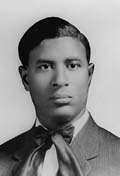Garrett A. Morgan
 Garrett was born on March 4, 1877, in Paris, Ky., USA. The son of former slaves, he received only a sixth-grade education but that did not stop his quest for knowledge. When he was a teenager, Garrett left his family’s farm in search of better opportunities. While living in Cincinnati, Ohio, USA, he hired a tutor and continued his studies in English grammar. He moved to Cleveland, Ohio, where he worked as a sewing-machine repairman for a clothing manufacturer. Experimenting with gadgets and materials to discover better ways to do things became Garrett’s passion. This passion turned him into an inventor.
Garrett was born on March 4, 1877, in Paris, Ky., USA. The son of former slaves, he received only a sixth-grade education but that did not stop his quest for knowledge. When he was a teenager, Garrett left his family’s farm in search of better opportunities. While living in Cincinnati, Ohio, USA, he hired a tutor and continued his studies in English grammar. He moved to Cleveland, Ohio, where he worked as a sewing-machine repairman for a clothing manufacturer. Experimenting with gadgets and materials to discover better ways to do things became Garrett’s passion. This passion turned him into an inventor.
One of Garrett’s inventions that brought him fame was the traffic signal. After witnessing a crash in which a car collided with a horse-drawn carriage carrying a little girl, Garrett decided to invent something to make traffic safer. He patented a folding electric traffic signal with “GO” and “STOP” signs that were systematically raised and lowered at intersections to bring order out of the chaos of regulating pedestrian and vehicle traffic on city streets. This was the precursor to the modern traffic light. In 1923, General Electric Co. bought Garrett’s patent for this device for $40,000. He also received patents in England and Canada for similar signal devices. With this invention, Garrett is often credited with creating an early example of what we know today as intelligent transportation systems.
On May 30, 1997, Secretary of Transportation Rodney E. Slater announced the Garrett A. Morgan Technology and Transportation Futures Program at the Garrett A. Morgan Elementary School in Cleveland. The program has three goals: 1) to build a bridge between America’s youth and the transportation community; 2) to support the development of improved educational technology that provides better ways for people to acquire new skills; and 3) to ensure that America’s transportation work force for the 21st century is technologically literate and internationally competitive. The program will serve as a catalyst to enhance transportation education at all levels by leveraging the U.S. Department of Transportation’s current technology, education and research programs and by forging public/private partnerships. By 2000, the program will have reached one million students.
Another one of Garrett’s inventions was the gas mask that came about because of repeated incidents of firefighters being overcome by smoke when attempting to put out fires in Cleveland. Garrett wanted to do something to help with this problem. So, in 1914 he obtained a patent for a breathing device he invented that consisted of a canvas hood placed over the head. A double tube extended from the hood and merged into a single tube at the back. The open end held a sponge soaked with water to filter out smoke and to cool incoming air.
Shortly after receiving this patent, Garrett had the opportunity to put his invention to the test. In 1916 a tunnel was being constructed under Lake Erie. One night, workers under the lake hit a gas pocket, which caused an explosion and trapped the workers in a steel crib 250 feet beneath the lake’s surface. Three rescue parties entered the tunnel, but the rescuers never came out. Officials familiar with Garrett’s breathing device summoned him. Garrett rushed to the scene with four of his safety hoods. Garrett, his brother and two volunteers put on the hoods and went in and out of the tunnel several times, pulling suffocating workers and rescuers to safety. This brought Garrett much notoriety and helped him sell his invention to fire departments across the country.
In 1914, Garrett received first grand prize at the Second International Exposition of Safety and Sanitation for his invention of a gas mask. For his bravery in the Lake Erie disaster in 1916, he received the Carnegie Medal and a Medal for Bravery from the City of Erie. Shortly before his death in 1963, the U.S. government awarded Garrett with a citation for inventing the traffic signal. Throughout his lifetime, Garrett used his creative energies for inventions that conveyed his concern for the safety of others.